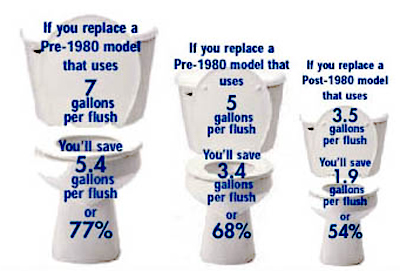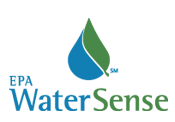| Home |
| Water System |
| Sewer System |
| Harbor and Bay |
| School Program |
| About MWRA |
| Doing Business with MWRA |
| Contact MWRA |
Water-Efficient Toilets
Massachusetts Water Resources Authority
|
LOW FLOW TOILETS
The toilet is the single biggest water user in your home. Flushing accounts for about one-third of the water used within your home each day.
Replacing an old model toilet with a new
low-consumption toilet could automatically and permanently cut your home water consumption by 25% or more.
The Massachusetts State Plumbing Code requires that all new or replacement installations of two-piece tank-type and
floor-mounted flushometer toilets use no more than 1.6 gallons per flush. These toilets are called low-flow, low-consumption or low-flush.
Information provided by the EPA WaterSense Program can help inform purchase decisions. This information will be useful, but should not substitute for the professional judgment of a licensed plumber or engineer.
HOW MUCH WATER DOES A LOW-FLOW TOILET SAVE? |
|---|
 Whether you replace one toilet in a single bathroom or several hundred toilets in a large commercial or residential complex, you can expect to see significant savings. For example, replacing a typical 3.5-gallon toilet with a 1.6 gallon model will save a family of four 11,096 gallons of water per year. That's a 54% reduction in toilet water use. The more water the toilet you're replacing uses, the more water -- and money you'll save. |
WATERSENSE LABELED TOILETS
Toilets are by far the main source of water use in the home, accounting for about one-third of residential indoor water consumption. Toilets also happen to be a major source of wasted water due to leaks and/or inefficiency. WaterSense ®, a program sponsored by the U.S. Environmental Protection Agency (EPA), is helping consumers identify high performance, water-efficient toilets that can reduce water use in the home and help preserve the nation's water resources. MWRA is an EPA Watersense Partner.
Advancements have allowed toilets to use 20 percent less water than the current federal standard, while still providing equal or superior performance. The WaterSense label is used on toilets that are certified by independent laboratory testing to meet rigorous criteria for both performance and efficiency. Only high-efficiency toilets that complete the third-party certification process can earn the WaterSense label.
REFERENCES AND PERFORMANCE TESTS
The American National Standards Institute (ANSI) designs minimum performance tests and standards for low-flow toilets. Make sure you choose a model that meets these standards. Several excellent studies have been conducted. Here is a list of resources for more information.
| REFERENCES - MORE INFORMATION ABOUT LOW-FLOW TOILETS |
|---|
| US EPA Watersense Labeled Toilets |
| TLC - How Stuff Works Ultimate Guide to Low-flow Toilets (web page) |
| Love Plumbing and Remodel Terry Love's Report on Low-flow Toilets for Consumers (web page) |
toiletology.com |
WHICH TYPE OF TOILET IS RIGHT FOR YOU?
Consider which of the residential low-flow toilet types is best for your home:
- Gravity Toilets are the most common. Water is stored in a tank and when flushed, the water is released through a flapper valve and driven by gravity to clear out the bowl. These toilets require approximately 10-15 pounds per square inch (psi) of pressure at the connection to function properly. Gravity toilets are relatively inexpensive, ranging from $100-$200.
- Pressure Assisted Toilets are hybrids of gravity and flush valve toilets. A pressurized tank placed inside the porcelain tank compresses a pocket of air and releases pressurized water into the bowl and out the trapway at high velocity. The flushing action of these toilets is noisier than the gravity types’, and they require a minimum water pressure of 25 psi to operate properly. Prices for these toilets are usually over $200.
- Flushometer Toilets are found in most commercial buildings. They have no tank but rely instead on a pressure-operated valve directly connected to the building’s water supply. They require a large supply pipe and a minimum water pressure of 23-40 psi to operate well. These toilets are priced at about $300.
Updated August 18, 2022
